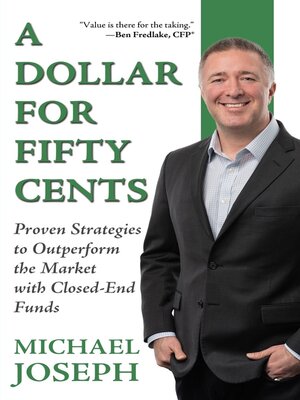A Dollar for Fifty Cents
ebook ∣ Proven Strategies to Outperform the Market with Closed-End Funds
By Michael Joseph

Sign up to save your library
With an OverDrive account, you can save your favorite libraries for at-a-glance information about availability. Find out more about OverDrive accounts.
Find this title in Libby, the library reading app by OverDrive.



Search for a digital library with this title
Title found at these libraries:
| Library Name | Distance |
|---|---|
| Loading... |
The Hidden Market Anomaly That Regularly Beats the S&P 500—How Smart Investors Buy a Dollar for Fifty Cents
For over a century, a peculiar and powerful anomaly has existed in the stock market—one that has allowed savvy investors to buy $1 worth of assets for just 50 cents. This isn't a gimmick. It's not a speculative trick. It's a documented, persistent market inefficiency that professional traders, fund managers, and even Warren Buffett himself have quietly leveraged to outperform the market for decades.
Yet most investors remain completely unaware of it.
This anomaly exists in closed-end funds (CEFs)—one of the stock market's most misunderstood and overlooked asset classes. Unlike traditional mutual funds and ETFs, CEFs trade at deep discounts to the net asset value (NAV) of their holdings, creating unique opportunities for those who understand how to capitalize on them.
Now, in A Dollar for Fifty Cents, veteran investor and portfolio manager Michael Joseph, CFA, unveils the hidden power of CEFs, showing investors how to profit from mispricings, avoid common pitfalls, and build a smarter, more profitable portfolio. Whether you're an individual investor, a financial advisor, or a portfolio manager, this book will transform the way you think about value investing and market inefficiencies.
Why Closed-End Funds? The Hidden Opportunity in an Overcrowded Market
The world of investing has changed. Traditional stock-picking has become more difficult than ever, with algorithmic trading, passive indexing, and hedge fund dominance making it harder for individual investors to gain an edge. But closed-end funds remain one of the last bastions of market inefficiency—an area where professional investors can still find undervalued assets that offer superior risk-adjusted returns.
Unlike mutual funds and ETFs, which are priced at their exact net asset value, CEFs can trade at significant discounts—sometimes 10%, 20%, or even 30% below the value of their holdings. These pricing gaps create exceptional opportunities for those who know how to exploit them.
Yet CEFs remain widely ignored by the financial media, underutilized by fund managers, and misunderstood by the investing public. Why?
They don't receive the marketing push that mutual funds and ETFs do.
Most financial advisors aren't trained to understand them.
Wall Street makes little money from them, so they're rarely promoted.
That's precisely why the opportunity exists—and why investors who understand CEFs can gain an edge over the broader market.
Inside the Book: What You'll Learn
1. The Mechanics of Closed-End Funds
What makes closed-end funds different from ETFs and mutual funds—and why this difference is critical to their value.
The history of CEFs and how they have persisted as an inefficiency for over a century.
How fund structures, NAV calculations, and pricing mechanics create opportunities for investors.
2. Why CEFs Trade at a Discount—And How to Profit from It
The closed-end fund puzzle—why these funds trade at discounts to their true value, and what it means for investors.
The psychological and structural factors that cause pricing discrepancies.
A breakdown of historical studies and market data proving that CEFs offer long-term excess returns.
3. The Five Key Metrics That Separate Winning CEFs from Losing Ones
Not all CEFs are good investments. Some remain cheap for a reason. This book breaks down the five essential criteriato determine whether a closed-end fund is a value play or a trap:
NAV Discount Trends – How...







